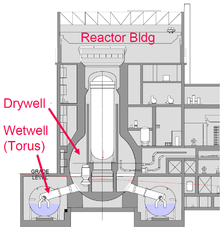Explosion at Unit 2
It was reported earlier today that the explosion at Unit 2 of the Fukushima Daiichi plant damaged the suppression chamber. As discussed in the previous post, the suppression chamber/torus (i.e. donut shape vessel containing water) is used to depressurize the reactor. The suppression pool is designed to condense the hot steam from the reactor, but can only do so as long as sufficient cold water remains in it. It should also be noted that the suppression pool is part of the primary containment.
Hydrogen gas from the cladding oxidation with steam collected in the suppression pool and ignited. This scenario differs from those of units 1 and 3 where the explosion occurred outside the primary containment in the upper part of the reactor building. The reasons why the steam/gas mixture was not released to the reactor building are still not clear. This breach of primary containment is certainly more serious than the situation in units 1 and 3. Seawater is still being pumped in the containment and the reactor vessel. At this time radioactive releases from unit 2 have been similar to the ones seen from units 1 and 3.
Fire at Unit 4 spent fuel pool
Recent reports by TEPCO indicate that an oil leak in a cooling water pump was the cause for the fire that burned for approximately 2 hours on Tuesday. On Wednesday morning (local time), another fire broke out, but it is reported the fire is not at the spent fuel pool. The cause is still unknown.
Reactor spent fuel pools
Spent fuel pools are used to cool down used nuclear fuel after it is removed from the reactor. The used nuclear fuel still contains residual heat from the radioactive decay of the fission product and must be stored in a cooled pool of water until intermediate or ultimate disposal. If insufficient cooling is provided to the pools, the water boils potentially exposing the spent fuel. As the temperature increases, the cladding would oxidize with the steam releasing hydrogen which can then ignite. This would also create fuel failures, releasing radioactive gases such as iodine, cesium and strontium.
It should be noted that unit 4 was under a 105-day long outage and that the fuel in the reactor had been moved to the spent fuel pool. Reports throughout the day indicated that the temperature of the spent fuel pool was increasing.
Current reports also indicate that the temperatures in the spent fuel pools of units 5 and 6 are also increasing.

